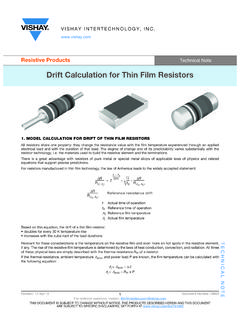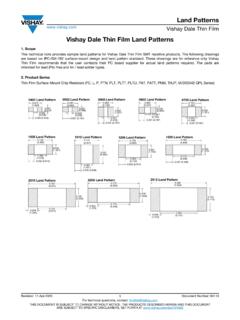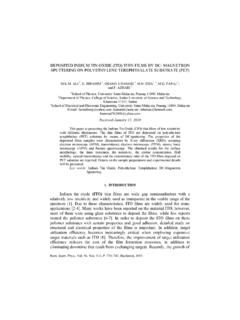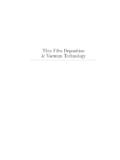Transcription of On the Stoney Formula for a Thin Film/Substrate System ...
1 On the Stoney Formula for a thin Film/Substrate System With X. Feng Nonuniform Substrate Thickness Y. Huang Current methodologies used for the inference of thin film stress through System curvature Department of Mechanical and Industrial measurements are strictly restricted to stress and curvature states which are assumed to Engineering, remain uniform over the entire Film/Substrate System . Recently Huang, Rosakis, and co- University of Illinois, workers [Acta Mech. Sinica, 21, pp. 362 370 (2005); J. Mech. Phys. Solids, 53, 2483 . Urbana, IL 61801 2500 (2005); thin Solid Films, 515, pp. 2220 2229 (2006); J. Appl. Mech., in press; J. Mech. Mater. Struct., in press] established methods for the Film/Substrate System subject A. J. Rosakis to nonuniform misfit strain and temperature changes. The film stresses were found to Graduate Aeronautical Laboratory, depend nonlocally on System curvatures ( , depend on the full-field curvatures). These California Institute of Technology, methods, however, all assume uniform substrate thickness, which is sometimes violated in Pasadena, CA 91125 the thin Film/Substrate System .
2 Using the perturbation analysis, we extend the methods to nonuniform substrate thickness for the thin Film/Substrate System subject to nonuniform misfit strain. DOI: . Keywords: thin films, nonuniform misfit strain, nonuniform substrate thickness, nonlocal stress-curvature relations, interfacial shears 1 Introduction often arbitrarily applied to cases of practical interest where these Stoney 1 used a plate System composed of a stress bearing assumptions are violated. This is typically done by applying thin film , of uniform thickness h f , deposited on a relatively thick Stoney 's Formula pointwise and thus extracting a local value of substrate, of uniform thickness hs, and derived a simple relation stress from a local measurement of the System curvature. This between the curvature, , of the System and the stress, f , of the approach of inferring film stress clearly violates the uniformity film as follows: assumptions of the analysis and, as such, its accuracy as an ap- proximation is expected to deteriorate as the levels of curvature Eshs2 nonuniformity become more severe.
3 F = 1 Following the initial formulation by Stoney , a number of exten- 6h f 1 s . sions have been derived to relax some assumptions. Such exten- In the above the subscripts f and s denote the thin film and sub- sions of the initial formulation include relaxation of the assump- strate, respectively, and E and are the Young's modulus and tion of equibiaxiality as well as the assumption of small Poisson's ratio, respectively. Equation 1 is called the Stoney deformations/deflections. A biaxial form of Stoney Formula with Formula , and it has been extensively used in the literature to infer different direct stress values and nonzero in-plane shear stress . film stress changes from experimental measurement of System was derived by relaxing the assumption v of curvature equibi- curvature changes 2 . Stoney 's Formula involves the following assumptions: axiality 2 . Related analyses treating discontinuous films in the form of bare periodic lines 3 or composite films with periodic i Both the film thickness h f and substrate thickness hs are line structures , bare or encapsulated periodic lines have also uniform, the film and substrate have the same radius R, been derived 4 6.
4 These latter analyses have removed assump- and h f hs R; tions iv and v of equibiaxiality and have allowed the existence ii The strains and rotations of the plate System are infinitesi- of three independent curvature and stress components in the form mal; of two, nonequal, direct components and one shear or twist com- iii Both the film and substrate are homogeneous, isotropic, ponent. However, the uniformity assumption vi of all of these and linearly elastic; quantities over the entire plate System was retained. In addition to iv The film stress states are in-plane isotropic or equibiaxial the above, single, multiple and graded films and substrates have two equal stress components in any two, mutually or- been treated in various large deformation analyses 7 10 . thogonal in-plane directions while the out-of-plane direct These analyses have removed both the restrictions of an equibi- stress and all shear stresses vanish;. v The System 's curvature components are equibiaxial two axial curvature state as well as the assumption ii of infinitesimal equal direct curvatures while the twist curvature vanishes deformations.
5 They have allowed for the prediction of kinemati- in all directions; and cally nonlinear behavior and bifurcations in curvature states that vi All surviving stress and curvature components are spa- have also been observed experimentally 11,12 . These bifurca- tially constant over the plate System 's surface, a situation tions are transformations from an initially equibiaxial to a subse- which is often violated in practice. quently biaxial curvature state that may be induced by an increase in film stress beyond a critical level. This critical level is inti- Despite the explicitly stated assumptions, the Stoney Formula is mately related to the systems aspect ratio, , the ratio of in-plane to thickness dimension and the elastic stiffness. These analyses also retain the assumption vi of spatial curvature and stress uni- Contributed by the Applied Mechanics Division of ASME for publication in the JOURNAL OF APPLIED MECHANICS. Manuscript received October 18, 2006; final manu- formity across the System .
6 However, they allow for deformations script received January 14, 2007. Review conducted by Robert M. McMeeking. to evolve from an initially spherical shape to an energetically 1276 / Vol. 74, NOVEMBER 2007 Copyright 2007 by ASME Transactions of the ASME. Downloaded 22 Apr 2008 to Redistribution subject to ASME license or copyright; see simplicity. The substrate is modeled as a plate since hs R. The Young's modulus and Poisson's ratio of the film and substrate are denoted by E f , f , Es, and s, respectively. Let u f and us denote the displacements in the radial direction in the thin film and substrate, respectively. The in-plane membrane strains are obtained from = u , + u , / 2 for infinitesimal de- formation and rotation, where , = r, . The linear elastic consti- tutive model, together with the vanishing out-of-plane stress zz = 0, give the in-plane stresses as E. = 1 + 1 + m , 1 2. where E , = E f , f in the thin film and Es, s in the substrate, and the misfit strain m is only in the thin film .
7 The nonvanishing axial forces in the thin film and substrate are Nr = . Eh dur 1 dr 2. ur + 1 + m r .. 2 . Fig. 1 A schematic diagram of a thin Film/Substrate System Eh dur ur with the cylindrical coordinates r , , z N = + 1 + m 1 2 dr r where h = h f in the thin film and hs r in the substrate, and once favored shape , ellipsoidal, cylindrical or saddle shapes that again the misfit strain m is only in the thin film . features three different, still spatially constant, curvature compo- Let w denote the lateral displacement in the normal z direc- nents 11,12 . tion. The curvatures are given by = w, . The bending mo- The above-discussed extensions of Stoney 's methodology have ments in the substrates are . not relaxed the most restrictive of Stoney 's original assumption vi of spatial uniformity which does not allow either film stress Eshs3 d 2w 1 dw and curvature components to vary across the plate surface. This Mr = + s 12 1 s2 dr2 r dr crucial assumption is often violated in practice since film stresses 3.
8 And the associated System curvatures are nonuniformly distributed over the plate area. Recently Huang et al. 13 and Huang and Eshs3 d2w 1 dw M = 2 s +. Rosakis 14 relaxed the assumption vi and also iv and v to 12 1 s dr2 r dr study the thin Film/Substrate System subject to non-uniform, axi- For nonuniform misfit strain distribution m = m r , the shear symmetric misfit strain in thin film and temperature change in stress along the radial direction at the Film/Substrate interface does both thin film and substrate , respectively, while Ngo et al. 15 . not vanish, and is denoted by . The in-plane force equilibrium studied the thin Film/Substrate System subject to arbitrarily nonuni- equations for the thin film and substrate, accounting for the effect form , nonaxisymmetric misfit strain and temperature. The most important result is that the film stresses depend nonlocally on of interface shear stress , becomes the substrate curvatures, , they depend on curvatures of the dNr Nr N.
9 Entire substrate. The relations between film stresses and substrate + =0 4 . dr r curvatures are established for arbitrarily nonuniform misfit strain and temperature change, and such relations degenerate to Stoney 's where the minus sign in front of the interface shear stress is for Formula for uniform, equibiaxial stresses and curvatures. the thin film , and the plus sign is for the substrate. The moment Feng et al. 16 relaxed part of the assumption i to study the and out-of-plane force equilibrium equations for the substrate are thin film and substrate of different radii, , the thin film has a smaller radius than the substrate. Ngo et al. 15 further relaxed dM r M r M hs + +Q =0 5 . the assumption i for arbitrarily nonuniform thickness of the thin dr r 2. film . The main purpose of the present paper is to relax the remain- ing portion in assumption i , , the uniform thickness of the dQ Q. substrate. To do so we consider the case of thin Film/Substrate + =0 6 . dr r System with nonuniform substrate thickness subject to nonuniform misfit strain field in the thin film .
10 Our goal is to relate film stresses where Q is the shear force normal to the neutral axis. Equation and System curvatures to the misfit strain distribution, and to ul- 6 , together with the requirement of finite Q at r 0, gives Q 0. timately derive a relation between the film stresses and the System The substitution of Eq. 2 into 4 yields the governing equa- curvatures that would allow for the accurate experimental infer- tions for u and , ence of film stress from full-field and real-time curvature mea- surements. d2u f 1 du f u f 1 2f d m + = + 1 + f 7 . dr2 r dr r2 Efhf dr . 2 Governing Equations and Boundary Conditions d dus us dhs us 1 s2. Consider a thin film of uniform thickness h f which is deposited hs + 1 s = 8 . on a circular substrate of thickness hs and radius R Fig. 1 . The dr dr r dr r Es substrate thickness is nonuniform, but is assumed to be axisym- Equations 3 , 5 , and 6 give the governing equation for w and metric hs = hs r for simplicity, where r and are the polar coor.





